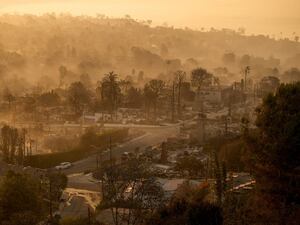Crowds flock to Pope Francis’ seaside mass in East Timor
The church service was held on the same spot where Pope John Paul II celebrated a historic liturgy during the nation’s fight for independence.

Tens of thousands of people in East Timor streamed to a seaside park for Pope Francis’ big mass on Tuesday, held on the same field where John Paul II celebrated a historic liturgy during the nation’s fight for independence from Indonesia.
The Tacitolu Park is said to have been a site where Indonesian troops disposed of bodies killed during their rule. Now it is known as the Park of Peace and features a larger-than-life-sized statue of John Paul to commemorate his 1989 visit, when the Polish pontiff shamed Indonesia for its human rights abuses and encouraged the overwhelmingly Catholic Timorese faithful.
John Paul’s visit helped draw attention to the plight of the Timorese people and shine a spotlight on the oppressiveness of Indonesia’s rule, during which as many as 200,000 people were killed over a quarter-century.

East Timor, known also as Timor-Leste, remains one of the poorest countries, with 42% of its 1.3 million people living below the poverty line, according to the UN Development Programme.
Unemployment is high, job opportunities in the formal sector are generally limited and most people are subsistence farmers with no steady income.
The territory has been overwhelmingly Catholic ever since Portuguese explorers first arrived in the early 1500s and 97% of the population today is Catholic. They have turned out in droves to welcome the first pope to visit them as an independent nation, thronging the motorcade route as Pope Francis arrived on Monday and pouring into the Tacitolu site .
Government authorities said some 300,000 people had registered through their dioceses to attend the mass, but President Jose Ramos-Horta said he expected 700,000 and the Vatican predicted as many as 750,000.
They lined up before dawn by the tens of thousands to enter the Tacitolu park, on the coast about 8 kilometres (nearly 5 miles) from downtown Dili. With hours to go until the service, the roads leading to it were jammed by cars, trucks and buses packed with people; others walked down the middle of the street, ignoring the sidewalks.
“For us, the pope is a reflection of the Lord Jesus, as a shepherd who wants to see his sheep, so we come to him with all our hearts as our worship,” said Alfonso de Jesus, who came from Baucau, the country’s second-largest city after Dili, about 75 miles east of the capital.
Mr de Jesus, 56, was among the estimated 100,000 people who attended John Paul’s 1989 Mass, which made headlines around the world because of a riot that broke out just as it was ending. John Paul looked on as baton-wielding Indonesian plain-clothed police clashed with around 20 young men who shouted “Viva a independência” and “Viva el Papa!”.
According to Associated Press reporting at the time, the men unfurled a banner in front of the altar and hurled chairs at the policemen. One banner read “Fretilin Welcomes You,” a reference to the independence movement that fought Indonesian rule since East Timor was annexed in 1976 after Portugal dismantled its centuries-old colonial empire.
Four women were reported hospitalised with injuries suffered after being crushed in the surging crowd. The pope was not harmed.
Amnesty International later expressed concern that some 40 people had been detained and tortured, though Indonesian authorities at the time denied any arrests or torture.
“The mass was run very neat and orderly with very tight security,” De Jesus recalled more than three decades later. “But it was crushed by a brief riot at the end of the event.”





